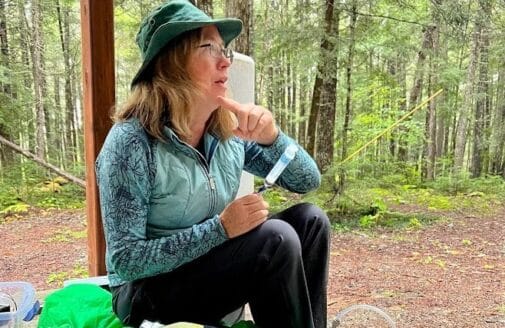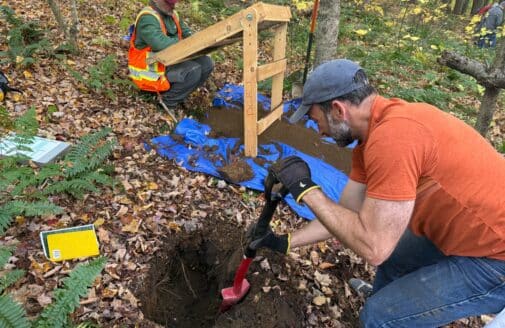Guiding principles for just, effective natural climate solutions

This document offers science-based principles to guide implementation of natural climate solutions (NCS) at national and sub-national scales. These principles broadly support the inclusion of NCS among measures needed to meet targets associated with the Paris Climate Agreement that establishes a global framework to limit warming to less than 2°C.
NCS employ “negative emissions,” or greenhouse gases removed from the atmosphere, and have a significant role to play in limiting warming along with emissions reductions. Land, inland waters, and coastal ecosystems currently remove about 30% of global annual carbon dioxide emissions, and have the potential to continue or even increase this critical carbon sequestration function—they could potentially deliver up to one-third of net emission reductions needed to remain within a 1.5- or 2-degree Celsius warming pathway by 2030 (Adams et al. 2021). Solutions that abate emissions using NCS are also estimated to be highly cost-effective when compared to engineered solutions, such as carbon capture, utilization, and storage (Griscom et al. 2020). Many forms of NCS are available to deploy immediately, at scale, without technological breakthroughs.
An advantage of NCS is that if carefully designed, the activities can have substantial co-benefits such as conserving biodiversity and protecting water supplies. However, realizing this potential will require careful analysis of options for deploying NCS, as well as monitoring of results which may be impacted by climate change.
The framework underlying these principles includes considerations of time, space, and community. The time dimension recognizes that natural climate solutions involve changes in ecosystems and ecosystem management that have impacts spanning decades and centuries. The effectiveness of a particular climate solution will vary over these timeframes—some will be effective in the short term, and some in the long term as climate changes and other factors evolve. Likewise, some will be ineffective at times and so the expected benefits as well as co-benefits need to be evaluated now and for the future.
The spatial dimension reflects that ecosystems are highly variable geographically, as are the various factors that influence ecosystems. For example, natural disturbances such as wildfire are much more common and severe in areas where drought and high temperatures are prevalent. Existing management practices are also highly variable, with some regions dominated by agriculture, some by forest management, and some by protection from human-caused disturbances. Potential solutions will be different for these categories, as will the effectiveness of each for reducing greenhouse gas emissions to the atmosphere.
The community, or human, dimension is critical because natural climate solutions are implemented by people within specific social and economic contexts. All solutions have consequences that go beyond the goal of reducing greenhouse gases, and people will be affected in different ways. Impacts may be positive, such as providing jobs or cooling communities by planting trees near buildings, or negative by increasing the costs of goods and services or impacting specific economic sectors, such as agriculture and the forest products industry.

The following principles are intended to help avoid specific unintended consequences of NCS implementation. Although the principles were developed with U.S. policies and programs in mind, the scope is not limited to U.S. borders, particularly considering that agricultural and forest products are internationally traded commodities, and that protecting biodiversity and reducing greenhouse gasses are globally recognized priorities.
- Protect, manage, and restore ecosystems to maintain or increase climate benefits.
Protecting threatened high-carbon ecosystems can avoid emissions and help protect biodiversity; the benefits are immediate and difficult to replace once lost, making ecosystem protection a top priority. Improved management can be applied at low cost over large areas, and can have substantial and enduring co-benefits. Restoring degraded land to native vegetation can increase biodiversity while increasing carbon stocks to levels consistent with the potential of the site over the long term. While important, restoration should not be viewed as an alternative to or replacement for protection.
- Consider risks from climate extremes, natural disturbances, and socioeconomic events.
Many NCS will take time to reduce net greenhouse gas emissions; exceptions are avoiding deforestation and forest degradation, delaying harvest, and reducing emissions from agricultural soils. Calculations of expected benefits must consider climate change and other factors that are likely to impact the outcomes of NCS.
- Engage Indigenous Peoples and local communities, and work to mitigate inequalities and injustices.
Natural climate solutions should be implemented with full engagement of Indigenous Peoples and local communities in ways that respect land, culture, and human rights. The historical legacies and ongoing effects of institutional racism necessitate particular care to include the knowledge and interests of these communities. Participatory engagement, negotiations, and consent are critical.
- Enhance human welfare and “do no harm.”
Natural climate solutions should aim to generate a net enhancement to human welfare, while doing no harm to impacted parties. If the tradeoffs between the private and public benefits from policy choices are clearly defined and quantified, potential negative outcomes can be identified and mitigated to the greatest extent possible. Unless natural climate solutions can be demonstrated to have clear overall benefits to society and impacted stakeholders, and private costs mitigated, they are unlikely to be adopted.
- Practice full-system accounting so that all effects on the carbon cycle are assessed, and the contributions of a given natural climate solution can be evaluated.
Assessing the climate impacts of natural climate solutions requires a systems approach because of the connections between agriculture, forests, land use, food and fiber production, and energy production. It is therefore essential to practice full-system carbon accounting, including the effects of activities on ecosystems and their ability to maintain or increase carbon stocks, as well as impacts on fossil fuel emissions from related economic sectors. Full-system accounting should be complemented with effective monitoring and reporting.
- Ensure that carbon credits used to finance natural climate solutions meet the highest standards of quality, integrity, and offset eligibility.
There are numerous financing models for natural climate solutions. Regulatory and voluntary carbon markets could be a significant source of funding for scaling up NCS, but their use needs to follow strict guidelines to ensure real climate benefits. Offsetting should only be used as a complement to—not substitute for—rigorous decarbonization efforts; this includes both immediate use as emissions are being reduced, as well as long-term use to offset hard-to-abate emissions. All carbon credits must be backed by thorough monitoring and accounting of both risks and benefits (as outlined in previous sections) to ensure quality and integrity.
This is an update to principles originally released in 2021. The authorship team consisted of Dr. Richard Birdsey, Natalie Baillargeon, Dr. Glenn Bush, Dr. Richard (Skee) Houghton, Dave McGlinchey, Dr. Sue Natali, Dr. Jonathan Sanderman, Dr. Wayne Walker, and Dr. Zach Zobel. In addition, five external reviewers contributed to the development of the original principles.
To learn more and read the paper in full, visit woodwellclimate.org/ncs-principles.










